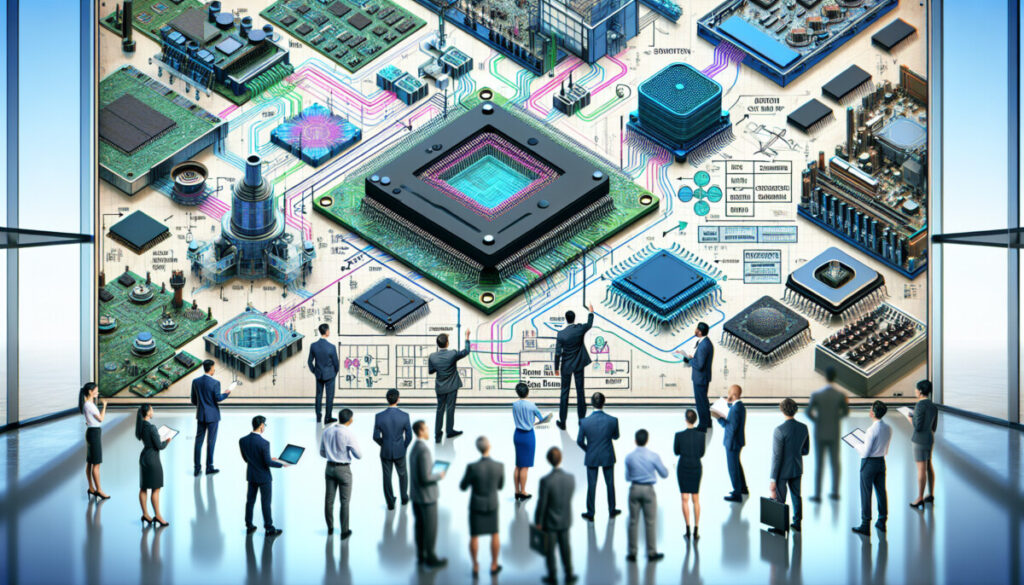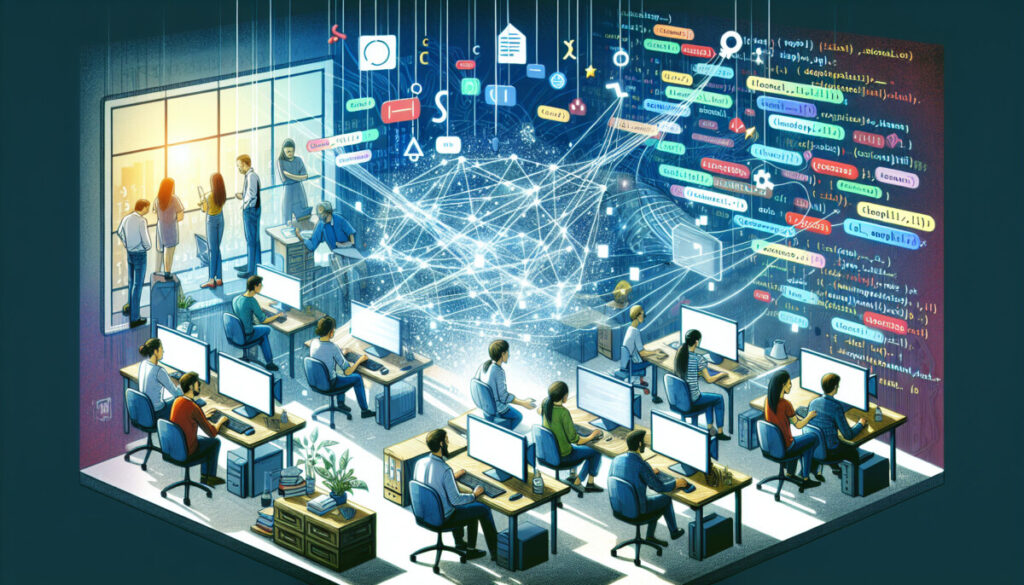Microsoft and Arm Holdings: Forging the Future of AI
Microsoft and Arm Holdings are two technology giants whose partnership is expected to shape the future of artificial intelligence (AI) significantly. While Microsoft is a global leader in software and cloud services, Arm Holdings is a renowned semiconductor and software design company. Together, their collaboration promises to revolutionise AI technologies and propel the industry to new heights.
Microsoft’s In-House Chip Development Strategy
Microsoft is making significant strides in its in-house chip development strategy, focusing on custom AI and cloud chips to stay at the forefront of technological innovation. By creating AI-specific processors, the company aims to improve performance and efficiency in various AI applications, including natural language processing and computer vision tasks.
At the core of this strategy are the Azure Maia AI Accelerator and Azure Cobalt CPU. The Maia AI Accelerator is designed to power language model training and inferencing, providing an efficient and scalable solution for AI workloads. Key features of this accelerator include its advanced design and capabilities, such as support for various precision levels, high-throughput compute, and large memory bandwidth. On the other hand, the Azure Cobalt CPU is an Arm-based processor focused on general-purpose compute workloads. This processor offers high-performance capabilities along with energy efficiency, making it a suitable choice for data centre environments.
The transition to Arm-based designs is another crucial aspect of Microsoft’s chip development strategy. As Arm Holdings’ technology gains traction in various computing segments, Microsoft is embracing these designs to stay competitive and provide diverse solutions to its customers. The shift towards Arm-based processors has significant implications for the industry, as it challenges the long-standing dominance of x86 architecture and opens up new possibilities for more efficient and versatile computing solutions.

Expanding Industry Partnerships for Diverse Infrastructure Options
Microsoft’s collaboration with NVIDIA, AMD, and other tech giants reflects the company’s commitment to providing diverse infrastructure options to its customers. By working together with industry leaders, Microsoft aims to offer a range of high-quality AI and cloud computing solutions that cater to the varied needs of different businesses and sectors.
One example of this collaboration is the inclusion of NVIDIA H100 and H200 Tensor Core GPUs and AMD MI300X accelerated virtual machines (VMs) in Microsoft’s Azure cloud platform. These advanced GPUs and VMs provide increased computational power and versatility, helping to drive innovation in AI and cloud-based services.
Microsoft’s goal to provide customers with infrastructure choices is rooted in its vision of fostering a multi-vendor ecosystem for Windows PCs with Arm-based processors. This strategy aims to reduce reliance on a single supplier and compete with Apple’s custom Arm-based chips, ultimately benefiting the end users by offering them a wider variety of high-performance computing options.
Arm Holdings’ Massive Growth Opportunity
Arm Holdings is experiencing significant growth, thanks to its partnerships with Microsoft and other cloud giants. These strategic collaborations are helping the company expand its reach and influence within the tech industry.
Microsoft’s new CPU, which uses Arm technology, is one example of how the partnership benefits both parties. By incorporating Arm’s cutting-edge technology, Microsoft can develop innovative solutions that meet the evolving demands of the computing world. This collaboration not only enhances Microsoft’s product offerings but also raises Arm Holdings’ profile in the market.
The future prospects for Arm Holdings are promising, with the potential to impact the tech industry significantly. As more companies embrace Arm-based designs for their computing solutions, the demand for Arm’s technology is expected to grow exponentially. This growth will not only strengthen Arm Holdings’ position in the market but also contribute to the overall advancement of AI and other cutting-edge technologies.
AI Integration in Microsoft and Arm-based Processors
Microsoft envisions artificial intelligence as an integral part of the Windows experience, transforming how users interact with their devices and applications. As a result, the company is working closely with Arm Holdings to develop processors with dedicated on-chip resources for AI functionalities.
These custom chips aim to provide a seamless and efficient AI experience across various platforms, benefiting users and developers alike. In addition to enhancing the performance of AI applications, these chips also contribute to the overall revolution of AI and cloud computing, enabling more powerful and accessible solutions for a wide range of industries.
By incorporating AI into the core of their processors, Microsoft and Arm are setting the stage for a new era in technology, where AI becomes an essential component of personal computing and cloud services. This collaboration will not only drive innovation in AI but also create new opportunities for businesses and consumers worldwide.
Challenges for Software Developers and Adapting Code
The transition from x86 architecture to Arm-based designs is a significant shift in the computing industry. This change not only affects hardware manufacturers but also presents challenges for software developers. As Arm-based processors become more prevalent in Windows PCs, developers need to adapt their code for compatibility with the new architecture.
One of the primary concerns for software developers is ensuring that their applications run smoothly on both x86 and Arm-based systems. This requires a deep understanding of the differences between the two architectures and an ability to optimise code for each platform. Moreover, developers need to consider the performance implications of their code changes, as Arm-based processors may have different performance characteristics than their x86 counterparts.
Microsoft’s promotion of Arm-based processors for Windows PCs is a clear indication of the company’s commitment to creating a multi-vendor ecosystem. This strategy aims to reduce reliance on a single supplier and compete with Apple’s custom Arm-based chips. However, this also means that software developers must be prepared to support multiple hardware architectures, which can increase development complexity and maintenance costs.
In conclusion, the move towards Arm-based designs in personal computing presents both opportunities and challenges for software developers. As the industry continues to evolve, it is crucial for developers to stay informed of the latest trends and adapt their code accordingly to ensure compatibility and optimal performance across different hardware platforms.

Future Developments and Second-Generation Azure Chips
As the partnership between Microsoft and Arm Holdings continues to flourish, plans are underway for the design and development of second-generation versions of the Azure Maia AI Accelerator Series and Azure Cobalt CPU Series. These next-generation chips aim to further enhance the capabilities of AI cloud services and general-purpose compute workloads, bringing even more innovative solutions to the market.
With the introduction of second-generation Azure chips, significant impacts on AI Cloud Services and server pricing are expected. By leveraging advanced technology from Arm Holdings and the expertise of Microsoft, these chips can potentially lead to more cost-effective and efficient cloud solutions. This, in turn, may enable businesses to scale their operations more effectively and access advanced AI functionalities at a lower cost.
Furthermore, Microsoft plays a crucial role in standardising data formats for AI models, ensuring seamless integration and compatibility across different platforms and applications. By promoting a unified approach to data formats, Microsoft is not only simplifying the development process for AI applications but also fostering collaboration and innovation within the industry.
In conclusion, the future developments of second-generation Azure chips, combined with Microsoft’s role in standardising data formats for AI models, will undoubtedly shape the future of AI and cloud services. As this partnership between Microsoft and Arm Holdings progresses, we can expect more groundbreaking advancements in AI technology and its applications across various industries.
Conclusion
In summary, the partnership between Microsoft and Arm Holdings is a significant development in the technology industry, particularly with respect to AI’s future. Both companies are working together to create powerful, efficient, and versatile chips that leverage Arm’s technology. This collaboration has the potential to reshape the landscape of AI and cloud computing as we know it.
As AI continues to advance, its impact on various industries is becoming increasingly apparent. The collaboration between Microsoft and Arm Holdings is an excellent example of how tech giants are joining forces to shape AI’s future. By developing custom chips and processors that integrate AI capabilities, these companies are enabling a new generation of intelligent applications and services. This partnership not only strengthens both companies’ positions in the tech industry but also demonstrates the vital role AI advancements play in shaping the future of various sectors.
Overall, the Microsoft and Arm Holdings partnership highlights the significance of AI advancements in shaping the future of technology and various industries. As we continue to see more collaboration and innovation in this space, it’s evident that AI will play an increasingly crucial role in our lives and the world around us.
Embrace AI’s Advancements
As Microsoft and Arm Holdings redefine the AI landscape, stay updated on the latest developments by visiting AutoGPT’s blog for more insights into AI advancements and industry news. Explore the capabilities and potential of AutoGPT , an AI system that can self-improve, and participate in AI challenges and hackathons with AutoGPT Arena Hacks . Discover the differences between Auto-GPT and ChatGPT and their respective roles in AI evolution by visiting AutoGPT vs ChatGPT . Embrace the future of AI and unlock its potential with AutoGPT.

